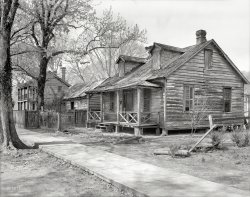
MAY CONTAIN NUTS

Search Shorpy
SHORPY ART

Framed or unframed, desk size to sofa size, printed by us in Arizona and Alabama since 2007. Explore now.
Join and Share
Ad-Free Shorpy
Shorpy is funded by you. Patreon contributors get an ad-free experience.
Learn more.

Recent comments
- +112
- Rear View
- Way in the back --
- Button It Up
- And with an eye on the time ...
- Working in an enclosed ashtray
- Rear View Mirror?
- Tobacco cam
- Basic fact I learned only later in life
- Put a Lid on it!
- Pinstripes in the Tower
- Sound enhancement
- 3438 in '38
- Second Career
- Their days are numbered
- Only the Sensor
- Train control mechanism
- Rarest of the Rare?? & Classy 3400 Class
- Control Mechanism
- Those standpipes
- Wrenches
- International D-40 I believe
- Job prospects
- You had me at Train
- Land of the free
- Broad-Exchange Bldg
- Parking innovation
- The old block
- "Peck turned a sweet propeller"
- National Bank Building
Member Photos
The Shorpy
Printporium
Printporium
Search Shorpy
Search results -- 30 results per page
- Law for Tombstone: 1939
- ... who lived in their (segregated, of course) dorm, and one night they all went downtown to see a Movie; dialog is approximate!
Ticket ... Posted by Dave - 10/06/2012 - 12:13pm -
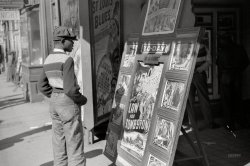
- Goes to School Now (He Says)
- ... in summer and sprinkled water on our sheets and pillows at night. Sometimes an alligator would stroll by the porch in the moonlight and ... Posted by Dave - 12/14/2007 - 3:09am -
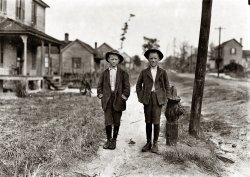
- Special Agent: 1943
- ... May 1943. Chicago. "Special agent making his rounds at night at the South Water Street freight terminal of the Illinois Central ... Posted by Dave - 12/18/2017 - 12:12pm -
![Special Agent: 1943 May 1943. Chicago. "Special agent making his rounds at night at the South Water Street freight terminal of the Illinois Central Railroad." Medium-format negative by Jack Delano for the Office of War Information. View full size.
You guys can be slick...by putting your "Shorpy" logo on that IC reefer in a nearly-matching font.
nice jobGreat job of placing the "Shorpy" in this photo. I'd bet Mr. Delano would've had a chuckle over of it like I did.
Long time exposure plus flashI do believe that this, in a way, is a self portrait. At least, in the style of the Renaissance painters who would include a likeness of themselves as one of the background crowd.
Based on the two bright streaks in the sky, likely planets rather than stars, this appears to be a rather long exposure as would be necessary to get a decent exposure of the buildings while using a moderately small aperture to get adequate depth of field. At some point during the exposure the person in the lower right (Delano probably) manually triggered a flash, lighting the rail cars and leaving themselves as a silhouette. Great technique (except the slight bump to the camera seen as a wiggle in the trails of the planets.
[The caption identifies the person in the lower right. It isn't Delano. -tterrace]
Channeling ShorpyHe would have loved this tribute, God rest his soul. Great choice of type by the way. Nicely done
Detective StoryThe agent's silhouette could very well be the logo of a detective story series, it's such a suggestive image! Wonderful image!
Shorpy RRReally like the Shorpy watermark on the box car.
(The Gallery, Chicago, Jack Delano, Railroads)](https://www.shorpy.com/files/images/SHORPY-8d18292u.thumbnail.jpg)
- Corpus Christi: 1943
- ... outside my window. I loved looking at it, especially at night. We moved to Corpus when I as a teenager and I lived there until I joined ... Posted by Dave - 12/05/2013 - 10:29am -
![Corpus Christi: 1943 June 1943. "Corpus Christi, Texas." The Ascension. Medium format negative by John Vachon for the Office of War Information. View full size.
There's a Red Flying Horse By the Road SideI saw this picture and the line above from the Kevin Welch song "Early Summer Rain" immediately popped into my head. He also has a nice story about memories of the red flying horse on his Blawg. I also have childhood memories of the red flying Pegasus above Mobil stations but they are much fuzzier.
Still ascending over DallasThe pegasus was originally the logo of the Dallas-based Magnolia Oil Company, which became part of Mobil Oil through a merger in 1959.
A renovated version of the logo "flies" atop the Magnolia Hotel in Dallas. A history can be found here: http://www.magnoliahotels.com/pdf/pegasus-article-121211.pdf
Escape from the mundaneThis is a classic photographic composition in my opinion, a study in stark contrasts, which includes a narrative: Earth and sky, dark and light, the simplicity of life, and the dream of winged escape from the mundane.
I'd recognize that shadow anywhere.Having pumped Ethyl as a wee lad, I wore the Mobil Pegasus on my chest while doing so.
Dave's Mobil in Blue Springs, Missouri.
Somebody knows, but I don'tWhat's the hoopy thing?
[A stand to hold a round sign, like those here and here. -tterrace]
Two thingsTwo things about this photo strike a chord with me. In 1969 (when I was nine) a had surgery at Parkland Hospital in Dallas. There was a Pegasus, perhaps the one in kirkbrewer's post, outside my window. I loved looking at it, especially at night. We moved to Corpus when I as a teenager and I lived there until I joined the Navy in 1982 (I haven't been back since, except for short visits). There's not a lot in this photo from which I can get my bearings, but it sure is as flat and nondescript as I remember.
(The Gallery, Gas Stations, Horses, John Vachon)](https://www.shorpy.com/files/images/SHORPY_8d31645a.thumbnail.jpg)
- Yuen Hing & Co.: 1921
- ... tables or silk brocade
Or see a bold and brassy night club show,
On the most exciting thoroughfare I know --
Grant ... Posted by Dave - 05/01/2015 - 2:05pm -
![Yuen Hing & Co.: 1921 "REO Speedwagon grocery truck, San Francisco, 1921." Compare with our previous Speedwagon. Glass negative by Christopher Helin. View full size.
Musically speaking,We're on Grant Avenue, San Francisco, California, USA.
[Most interesting. I wonder how one would travel there. - Dave]
[Ideally in a trolley, but you have to settle for a cable car. -tterrace]
Weather-beatenLots of mud splatters. Could be from riding the storm out.
Can't fight this feeling anymore...I like this truck.
Stopping distanceI wonder what the stopping distance was for one of these trucks when fully loaded, using rear wheel only mechanical brakes, on a steep San Francisco hill. Lots of smoke, then right into the Bay!
Having Learned To Drive in San FranciscoOne learned quickly the streets that were too steep to comfortably drive. Trucks, unless they were delivering locally, were usually banned from streets like Divisadero (seen in the movie "Bullit"). These delivery trucks usually had a "granny gear" which was a very low 1st gear and would hold the vehicle to a crawl when descending steep hills. Brakes were not usually needed.
Chinatown Telephone ExchangeOn the side door of the truck you can see the letters "PHONE CHINA" and the beginning of a numeral. San Francisco's Chinatown had its own telephone exchange from 1887 until the 1940s when dial phones replaced the switchboard operators. How it all worked is explained here.
A Hundred Million Miracles"Grant Avenue San Francisco" was in Rodgers and Hammerstein's Broadway hit "Flower Drum Song" from 1958. The film version released in 1961 was nominated for 11 Academy Awards.
Western street with Eastern manners,
Tall pagodas and golden banners,
Throw their shadows through the lantern glow.
You can shop for precious jade
or teakwood tables or silk brocade
Or see a bold and brassy night club show,
On the most exciting thoroughfare I know --
Grant Avenue, San Francisco,
California, U.S.A.
Looks down from Chinatown
Over a foggy bay.
You travel there in a trolley,
In a trolley up you climb,
Dong! Dong! You're in Hong Kong,
Having yourself a time.
You can eat, if you are in the mood,
Shark-fin soup, bean cake fish.
The girl who serves you all your food
Is another tasty dish!
You know that
You can't have a new way of living
Till you're living all the way
On Grant Avenue --Where is that?--
San Francisco, That's where's that!
California, U.S.A.!
(The Gallery, Cars, Trucks, Buses, Chris Helin, San Francisco, Stores & Markets)](https://www.shorpy.com/files/images/SHORPY-326-01.thumbnail.jpg)
- H Street Market: 1920
- ... a set number of loves a day, but the bread was baked at night and delivered at dawn before the store opened. The delivery driver and ... Posted by Dave - 05/17/2014 - 10:23pm -
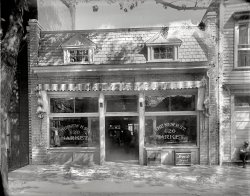
- Color Wheels: 1943
- ... on the B&O RR. We'd leave them a few cars about every night, just inside their gate. They moved them around in their facility with ... Posted by Dave - 08/16/2017 - 12:03pm -
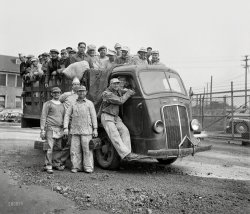
- Greetings From Camden: 1938
- ... Welles fella with all that crazy talk on the radio last night about Martians?
(The Gallery, Arthur Rothstein) ... Posted by Dave - 04/27/2008 - 5:03pm -
![Greetings From Camden: 1938 October 1938. "Homes near the gas works. Camden, New Jersey." 35mm negative by Arthur Rothstein for the Farm Security Administration. View full size.
Who knew?Looks like Camden has been the worst place in the world for a good while now.
Oh, Anonymous.You made me laugh out loud.
(Unlike this picture, which is SO depressing...)
The Gashouse GangNo, I'm not referring to the St. Louis Cardinals of 1934, although I understand they got their nickname due to the fact that these large storage tanks were a fixture in many Eastern cities up to the 1950s.
When I was a child, our neighborhood had one that was at least five times the size of this one. I recall it must have been the height of a 30 story building. To call it gigantic might have been an understatement.
Its size always intimidated me; it was an imposing landmark that could be seen for miles around. Up close it made the wooden utility poles beside it look like little toothpicks. The superstructure had pulleys that would allow the tank to expand upward or contract down as the volume of gas increased or decreased.
With the advent of natural gas coming east, these structures became redundant and largely disappeared from the urban landscape.
I've been looking for photos of these tanks; thanks for posting this one.
[Very interesting. So where was it? More pix here and here and here. - Dave]
P.U.There was one in Columbia, SC, when I was a kid. It smelled like a skunk.
Was that there before we went to bed?And who's this Orson Welles fella with all that crazy talk on the radio last night about Martians?
(The Gallery, Arthur Rothstein)](https://www.shorpy.com/files/images/8a10219u2.thumbnail.jpg)
- Ray Schalk: 1924
- ...
On the Topic of Baseball Tonight will be opening night for the Washington Nationals in their brand new ballpark ... took the ... Posted by Dave - 03/07/2008 - 5:16pm -
![Ray Schalk: 1924 "Schalk, Chicago, 1924." View full size. National Photo Company Collection.
BaseballI just can't wait for the season to begin. Thanks for posting these classic pics of the great game.
RayThere's a soon-to-be published biography on Ray Schalk coming from Brian Cooper, a journalist and fan of the "deadball" era of baseball and the Chicago White Sox during the early years of the past century.
Cooper's biography of White Sox pitcher (and spitball artist) Red Faber is a wonderful evocation of that era. Schalk caught a majority of Faber's 254 career winning games.
[It'll be interesting to see what they use for cover art. - Dave]
On the Topic of BaseballTonight will be opening night for the Washington Nationals in their brand new ballpark ... took the virtual tour at their official website ... incredible place.
Also... using photos from the National Photo Company Archives at the LOC ... have a "baseball project up at youtube.com, in time for the opening of the 2008 season ...
http://www.youtube.com/watch?v=w_idXc_3rus
even includes a bit of Harry Carey, and Abbott and Costello
Dale
BaseballDale, it's excellent - thank you
Opening DayAnother great one, Dale. Thank you
(The Gallery, Natl Photo, Sports)](https://www.shorpy.com/files/images/11567u_0.thumbnail.jpg)
- New Magnolia: 1906
- ... mirror. Rooms that didn't include a toilet rented for $5 a night. Every floor had a public bathroom that people who rented those rooms ... access to a toilet and sometimes a bathtub rented for $7 a night. The bathroom was situated between two hotel rooms, with a door on either ... Posted by Dave - 11/15/2018 - 1:47pm -
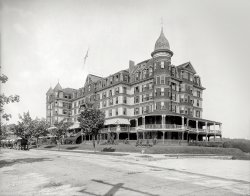
- Stop and Go: 1941
- ... could wait until I checked into my hotel room for the night.
Now Banned in Brattleboro Vermont prohibited billboards in 1968, ... Posted by Dave - 02/14/2019 - 2:43pm -
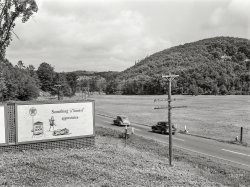
- Cuppa Joe: 1940
- ... out of business. It had nothing to do with Joe, but one night, very late, my spouse and I were there for dinner and they were closing ... Posted by Dave - 04/01/2016 - 8:28pm -
![Cuppa Joe: 1940 San Francisco circa 1940. "Joe DiMaggio and friend pouring coffee in restaurant kitchen." Prequel to this curious image. 5x7 nitrate negative. View full size.
A possibilityHaving lived in San Fran from 1962 until 1966, I enjoyed lots of seafood at Fisherman's Wharf and at that time, there was a DiMaggio's Restaurant owned and operated by Joe's uncle and cousins that has since (long ago) gone out of business. It had nothing to do with Joe, but one night, very late, my spouse and I were there for dinner and they were closing up the place, not even a half dozen people remained, and who do you think came in, alone, to visit with his family, tanned like a coffee bean, dressed impeccably and elegantly in a very sharply tailored suit, shined shoes, hair perfectly groomed and striking in his handsomeness? Yes, it was THE Joe DiMaggio and he was very polite and gracious to the few people who were still there. We got his autograph, for my son, on one of their menus but like everything else in my house I cannot find it. I do know it is here somewhere though and this is a true story. I have been told that the many current restaurants around the U.S. with names like joe dimaggio's , etc. are not family-owned or connected to Joe in any way.
Joe's BroThere seems to be only one picture of him online, but "Joe's friend" is, almost certainly, his brother, Tom.
[Doesn't look much like Tom DiMaggio. -tterrace]
Hmmm.... further investigation shows this to be Tom Laird, a noted sports writer. It was, confusingly, tagged as Tom and Joe DiMaggio. This photo was taken about 10 years after the coffee pic. He does bear a striking resemblance to the mystery man.
[No he doesn't. Tom Laird had a big cleft in his chin. - Dave]
Joe's WatchAny vintage watch collectors out there? What type of watch does Joe have on? Hamilton? Waltham? Elgin? Can anyone identify it?
Not relatedAs to it being Vincent Marotta? Maybe, but I wonder about the time/age issue.
[Mr. Coffee inventor Marotta was sixteen years old in 1940. -tterrace]
George Thierbach, America's "Mr. Coffee" of 1940Aha--solved it! Arcadia (CA) Tribune, 21 March 1940. The picture's caption solves the puzzle; Googling Mr. Theirbach turns up a bit more for the curious. TWELVE cups daily--wow!!!
[Excellent, thank you! -tterrace]
(The Gallery, Eateries & Bars, Kitchens etc., San Francisco, Sports)](https://www.shorpy.com/files/images/SHORPY-938A.thumbnail.jpg)
- Streets of San Francisco, Cont'd
- ... everywhere! That street must have been quite a sight at night! I'm really looking forward to the day when old-fashioned neon signs ... Posted by rsyung - 07/28/2014 - 3:36pm -
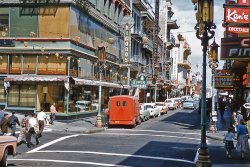
- The Letter: 1906
- ... is evident. Makes me want to go to a ball and waltz the night away!
(The Gallery, Gertrude Kasebier, NYC, Portraits) ... Posted by Dave - 08/09/2012 - 12:39am -
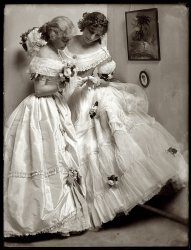
- The Light Refreshment: 1957
- ... York, 1957. "Broadway Theatre District -- Times Square at night." Now playing at Loew's State: "The Sweet Smell of Success." 35mm ... Posted by Dave - 02/21/2018 - 6:08pm -
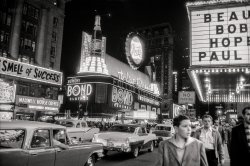
- Fate of the Rebel Flag: 1861
- ... the blue field with seven stars being formed by the night sky. Lightning strikes the flag from the upper left. View full size. ... Posted by Dave - 07/05/2009 - 3:01am -
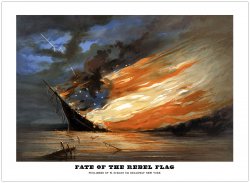
- Tailgater: 1943
- ... (Born too late for stream.) The best visit was a late night Thanksgiving with a gentle snow & 2 caboose back to back with ... Posted by Dave - 04/25/2015 - 9:35pm -
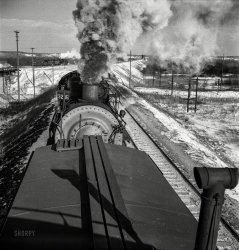
- The Deputy: 1938
- ... won. Soon after his original win in 1934, Platt replaced a night jailer with his own pick, resulting in litigation about whether the ... Posted by Vintagetvs - 04/01/2016 - 11:02am -

- Hello Up There: 1929
- ... enjoy the lamps, all cleverly shaded to not interfere with night vision.
Read more about it here .
WOW How did he stand all ... Posted by Dave - 06/26/2013 - 10:51am -
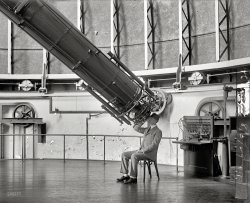
- Durward Nickerson: 1914
- ... 18 years old. Lives in Bessemer, R.F.D. #1. Saturday night, Sept. 26, 1914, he took investigator through the old Red Light on Avenue ... Posted by Dave - 08/26/2011 - 3:49pm -
![Durward Nickerson: 1914 "Durward Nickerson, Western Union messenger #55. Birmingham, Alabama. 18 years old. Lives in Bessemer, R.F.D. #1. Saturday night, Sept. 26, 1914, he took investigator through the old Red Light on Avenue A, pointed out the various resorts, told about the inmates he has known there. Only a half dozen of them were open now. Durward has put in two years in messenger work and shows the results of temptations open to him. He has recently returned from a hobo trip through 25 states. He was not inclined to tell much about the shady side of messenger work, but one could easily see that he has been through much that he might have avoided in a profitable kind of work." View full size. Photo by Lewis Wickes Hine.
Lewis HineLewis Wickes Hine: Photographer, social reformer and busybody party-pooper extraordinaire.
Shady workI had no idea messenger work could be so seedy.
LisaHe looks old beyond his years. Great idea for a blog. I subscribed to your feed.
Durward NickersonDurward M. Nickerson was the son of Otis Graham Nickerson & Hattie E. Shepard, great-grandparents of my husband, Jack Graham Weaver. Durward died in 1937 in Bernalillo County, New Mexico, at the age of 42.
Patsy Weaver
[Oh my. What happened? Did he leave a family? Thanks for the info. He seems like a dashing young man. - Dave]
(The Gallery, Birmingham, Lewis Hine)](https://www.shorpy.com/files/images/03932u_1.thumbnail.jpg)
- Instant Message: 1942
- ... freezing, moist, winter air. Need I say more? One night a new kid on the block weighed about 100 cars, and he asked the ... Posted by Dave - 04/26/2013 - 11:47am -
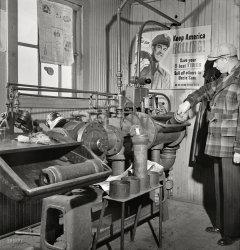
- Park Avenue Noir: 1958
- January 3, 1958. "Seagram Building. Night view, Park Avenue." Large-format acetate negative by Samuel H. Gottscho. ... Posted by Dave - 08/23/2013 - 12:13pm -
![Park Avenue Noir: 1958 January 3, 1958. "Seagram Building. Night view, Park Avenue." Large-format acetate negative by Samuel H. Gottscho. View full size.
A less dominant viewRecessing the Seagram Building behind a plaza was an innovative idea at the time but now means that it doesn't particularly dominate the Park Avenue streetscape. If you go a block or two north and look to the south, similar to the view in this photo, you'll barely see the Seagram Building at all as most of it is blocked by its next door neighbor at 399 Park Avenue. That 41-story building, which opened in 1961, is built out to the sidewalk line and hence much more visible. Fortunately, the Seagram Building is more visible from the south, as its southerly neighbor at 345 Park is also recessed from the sidewalk line. That building was a decade in the future at the time of this photo, and some older buildings are seen on what became its site.
To the Seagram Building's right, further south on Park, the towers of the Waldorf-Astoria are in plain sight. Like the Seagram Building, the Waldorf has had remarkably few exterior changes over the decades. While I'm not positive, I believe that the building under construction to the left of the Seagram Building is 750 Third Avenue. It was one of the first of the big office buildings to sprout up along Third Avenue following the demolition of the Third Avenue El in 1955. While the loss of the El was a major setback to the city's transportation infrastructure, one which has never been (and probably never will be) remedied, it did make formerly down-at-the-heels Third Avenue a desirable location for businesses.
After doing a bit of research it's apparent that the photo's date is incorrect. It had not snowed for at least two weeks prior to January 3, 1958 (yes, old weather records are easily found online), and any snow that had fallen earlier in December would have melted in the unseasonably warm weather at year's end and on New Year's Day.
A bigger issue is the construction site just to the north of the Seagram Building, where 399 Park Avenue now stands. Construction on 399 Park Avenue did not begin until 1959. It may be that the developers had cleared the lot by the beginning of 1958, and erected a fence around the property, but did not start actual construction for another year. I haven't had any luck trying to research this situation online.
MoodyCue up Park Avenue Beat (Perry Mason Theme Song)
I can hear my father now..."Every light in the building is on! Do you kids have any idea of how expensive electricity is?"
Too Lazy to Sweep off the SnowI guess that, since the invention of the automobile, there have always been those people that can't be bothered to fully remove the snow from their car. At least they cleared the windows. That appears to be a 1953 or 1954 Ford.
The car that looks alarmingly like it is going the wrong way down the road at a quick glance, due to the bright tail lights and front-end-shaped back end is a 1956 or 1957 Ford. Not sure about the others. I'm sure a car expert will show up to ID those.
[1957. -tterrace]
We Try HarderThe snow laden automobile in the foreground was a rented car. The NY State license plate 2Z1949 that year was yellow numerals on a black background. The colors were reversed every so often, The letter Z indicated a rented car. That practice ended in 1993 when a tourist drove a rented car out of an airport and was followed by armed thieves who then robbed, shot and killed him. Arriving travelers were chosen because they usually carried large sums of money and jewelry.
CarsThe snow-covered Ford looks like a 1954; the 1953s had different tailights. The car next to the 1957 Ford is a 1955 Plymouth. The car next to it is hard to make out but may be a 1955-56 Oldsmobile.
(The Gallery, Cars, Trucks, Buses, Gottscho-Schleisner, NYC)](https://www.shorpy.com/files/images/SHORPY_5a16908u.thumbnail.jpg)
- Fire: 1926
- ...
There were lively times in the "Division" last night. About 10 o’clock Officers Flathers and Kilmartin took a girl, who ... Posted by Dave - 09/04/2012 - 2:46pm -
![Fire: 1926 Washington, D.C. "Fire at Thomas Somerville plant, July 20, 1926." 312 13th Street N.W. National Photo Company Collection glass negative. View full size.
GoneIt looks like the entire block was razed a long time ago, and the Ronald Reagan Building and International Trade Center stands on the site now.
ApparatusI may be wrong (I often am), but would guess the fire apparatus at right was probably once a horse-drawn ladder wagon, and a motor tractor was added in place of the "old" horse power.
A hot time in the old houseNo. 312 Thirteenth Street had a colorful history. Washington Post article of Dec. 16, 1895 gives a glimpse into the neighborhood's earlier character.
Three Disorderly Houses Raided.
There were lively times in the "Division" last night. About 10 o’clock Officers Flathers and Kilmartin took a girl, who said her name was May Martin, out of the house of Lizzie Peterson, 1309 D street. At the First precinct station house the girl was charged with being under age. She claims that she is twenty-two years old.
An hour later the house of Alice Linden, 312 Thirteenth street, was raided by Sergt. Shilling and a squad of officers. Mrs. Linden and six women were captured. They were taken to No. 1 station house and charged with keeping a house of ill repute.
[Since "The Division" was in Northwest, this would seem to be the same address, as opposed to 312 13th Street Southeast, Southwest or Northeast. - Dave]
"The Division" explainedDuring the Civil War, General Hooker's command was stationed in Washington, DC. The rowdy troops gave so much business to the local houses of ill repute that the entire red-light district was nicknamed "Hooker's Division" and hence led to the later practice of a prostitute being referred to as a "hooker."
[I think that's been pretty much debunked as legend. Prostitutes were called hookers well before the Civil War. - Dave]
American LaFranceThe fire truck is an American LaFrance Type 31 circa 1916. This model was made all the way through 1929 without many changes. This is D.C. Truck No. 1 as shown on the raised ladder.
What is really interesting about these models is that the driver's seat swivels with the ladder. Look behind where the fireman is standing on the truck and you see the driver's seat facing backwards. Note also the dual front tires found on the earlier of these models.
The Washington, D.C. Fire Department also had a 1922 American LaFrance Model 31 with a 75-foot spring-raised water tower (water cannon/snorkel). This was Water Tower No. 2. It served the city for more than 30 years.
I hope the water pressure doesn't change and cause the hose on the sidewalk to topple the ladder on the sidewalk.
(The Gallery, D.C., Fires, Floods etc., Natl Photo)](https://www.shorpy.com/files/images/16076u.thumbnail.jpg)
- Fun With Freon: 1953
- ... remember her.
Your Show Of Shows Every Saturday night our family (mom, dad, older sister, younger brother and yours truly) ... Posted by Dave - 09/12/2013 - 6:41pm -
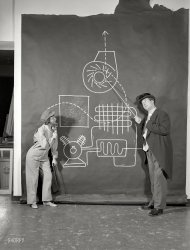
- More Friendly Than The Bates Motel
- ... windows that open to a cross breeze" and it's only $35/night.
I've stayed in small town motels that weren't much more than ... Posted by BernieSC - 09/20/2011 - 9:31pm -
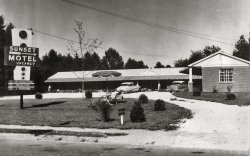
- Low Noon: 1936
- ... a duster rolled into town and made everything as dark as night. To avoid breathing the dust, we tied handkerchiefs over our noses while ... Posted by Dave - 08/18/2008 - 3:41pm -
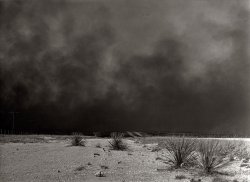
- Livingston Channel: 1910
- ... heavy steam equipment! If you transit this channel at night it looks just like an airport runway being so straight and lighted at the ... Posted by Dave - 07/28/2012 - 4:41pm -

- Glad Tidings: 1920
- ... of its work. Two gospel services are conducted every night, one in John Marshall Place and the other at the Georgetown Branch, ... Posted by Dave - 09/11/2011 - 1:14pm -
![Glad Tidings: 1920 "Gospel Mission, Georgetown Sunday school group, circa 1920." View full size. National Photo Company Collection glass negative, Library of Congress.
15 cent mealsThis photo is the southeast corner of 30th and M in Georgetown - now one of the swankiest strips in Washington. I believe this building still stands. John Marshall Place no longer appears on D.C. maps. It seems to have been a side street where the E. Barrett Prettyman Federal Courthouse is now located.
Washington Post May 18, 1919
Meals at 15 Cents in Gospel Mission
Average price per meal, 15 cents. One might think this is the wording of some utopian signboard. But here's the truth of it:
Right here in Washington, where in a restaurant a dollar vanishes like thin air, the Gospel Mission, 214-216 John Marshall place, has put Old Man H.C of L. [High Cost of Living] to rout by serving 15-cent meals. Not only this, but according to Herbert W. Kline, superintendent of the mission, 5,878 free meals were served this year.
But the Gospel Mission does not specialize in meals alone. From the report of Superintendent Kline 36,211 persons attended services held by the mission and 427 professed conversion. More than 1,000 requests were made for prayer. Forty-four jail services were held, 58 families sheltered and 1,400 babies treated at the diet kitchen.
During the past year the mission has greatly enlarged the scope of its work. Two gospel services are conducted every night, one in John Marshall Place and the other at the Georgetown Branch, Thirtieth and M streets. A Chinese Sunday school also is in operation.
The thirteenth anniversary of the mission is celebrated today.
SardinesThis reminds me of the old school bus from the weirdo baptist church in Washington, Iowa, that collected kids in neighboring towns. The wire on the sides of that truck—and their destination—sure says “paddy wagon” to me.
And I bet they had a well–used jack in that tool box.
SardinesThey didn't need no stinkin' jack, they had all those kids!
Model TThe smaller Model T Ford to the left is an early version with a brass radiator shell. And she doesn't look too happy with that load on her as the right side of the hood is open and could use some air in the tires.
The larger truck is a Model TT Ford, a little newer with a stamped sheet metal radiator shell. And built to be a heavy duty truck with a longer frame and solid rubber rear tires.
Tha nks for these great pictures!
(The Gallery, Cars, Trucks, Buses, D.C., Kids, Natl Photo)](https://www.shorpy.com/files/images/29082u.thumbnail.jpg)
- Unread Messages: 1943
- ... of a hot firebox is dazzling - it would take away one's night vision for a while.)
(The Gallery, Jack Delano, Railroads) ... Posted by Dave - 08/07/2016 - 12:21pm -
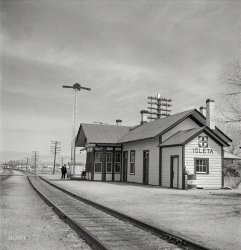
- Mansfield Quarters: 1936
- ... Sunday, as Sundays were reserved for Church (morning and night services) and some much needed down time in between and afterwards.
... Posted by Dave - 07/08/2013 - 5:00pm -
